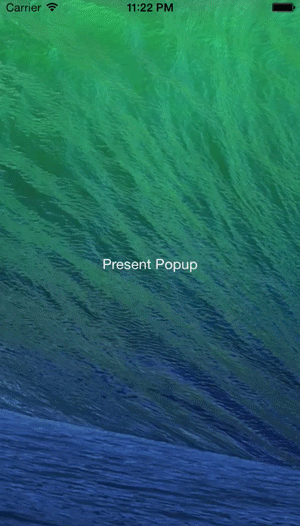August 22, 2013
Recently, I've gotten back into iOS Development. One of the UI elements that I've thought about adding a good few times is a popup view controller, so I went ahead and made it. 
To make the popup view controller, I added a category on UIViewController. I added two basic methods to present and dismiss the popup view controller.
Presenting the popup view controller:
- (void)presentPopupViewController:(UIViewController *)viewControllerToPresent animated:(BOOL)flag completion:(void (^)(void))completion {
// setup
self.popupViewController = viewControllerToPresent;
CGRect frame = viewControllerToPresent.view.frame;
CGFloat x = ([UIScreen mainScreen].bounds.size.width - viewControllerToPresent.view.frame.size.width)/2;
CGFloat y =([UIScreen mainScreen].bounds.size.height - viewControllerToPresent.view.frame.size.height)/2;
CGRect finalFrame = CGRectMake(x, y, frame.size.width, frame.size.height);
// shadow setup
viewControllerToPresent.view.layer.shadowOffset = CGSizeMake(0.0f, 0.0f);
viewControllerToPresent.view.layer.shadowColor = [UIColor blackColor].CGColor;
viewControllerToPresent.view.layer.shadowRadius = 3.0f;
viewControllerToPresent.view.layer.shadowOpacity = 0.8f;
viewControllerToPresent.view.layer.shadowPath = [UIBezierPath bezierPathWithRect:viewControllerToPresent.view.layer.bounds].CGPath;
// rounded corners
viewControllerToPresent.view.layer.cornerRadius = 5.0f;
// black uiview
UIView *fadeView = [UIView new];
fadeView.frame = [UIScreen mainScreen].bounds;
fadeView.backgroundColor = [UIColor blackColor];
fadeView.alpha = 0.0f;
[self.view addSubview:fadeView];
objc_setAssociatedObject(self, &CWFadeViewKey, fadeView, OBJC_ASSOCIATION_RETAIN_NONATOMIC);
if (flag) { // animate
CGRect initialFrame = CGRectMake(finalFrame.origin.x, [UIScreen mainScreen].bounds.size.height + 10, finalFrame.size.width, finalFrame.size.height);
viewControllerToPresent.view.frame = initialFrame;
[self.view addSubview:viewControllerToPresent.view];
[UIView animateWithDuration:ANIMATION_TIME delay:0 options:UIViewAnimationOptionCurveEaseInOut animations:^{
viewControllerToPresent.view.frame = finalFrame;
fadeView.alpha = FADE_ALPHA;
} completion:^(BOOL finished) {
[completion invoke];
}];
} else { // don't animate
viewControllerToPresent.view.frame = finalFrame;
[self.view addSubview:viewControllerToPresent.view];
[completion invoke];
}
}Dismissing the popup view controller:
- (void)dismissPopupViewControllerAnimated:(BOOL)flag completion:(void (^)(void))completion {
UIView *fadeView = objc_getAssociatedObject(self, &CWFadeViewKey);
if (flag) { // animate
CGRect initialFrame = self.popupViewController.view.frame;
[UIView animateWithDuration:ANIMATION_TIME delay:0 options:UIViewAnimationOptionCurveEaseInOut animations:^{
self.popupViewController.view.frame = CGRectMake(initialFrame.origin.x, [UIScreen mainScreen].bounds.size.height, initialFrame.size.width, initialFrame.size.height);
fadeView.alpha = 0.0f;
} completion:^(BOOL finished) {
[self.popupViewController.view removeFromSuperview];
[fadeView removeFromSuperview];
self.popupViewController = nil;
[completion invoke];
}];
} else { // don't animate
[self.popupViewController.view removeFromSuperview];
[fadeView removeFromSuperview];
self.popupViewController = nil;
fadeView = nil;
[completion invoke];
}
}Because there is an option to dismiss without animation, it is also possible to implement custom dismissal animations as well as gesture-based dismissal. You can find the project on my GitHub page.